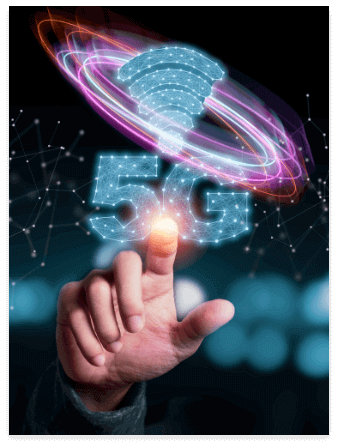As the demand for connection grows, especially with 70% of the U.S. workforce relying on wireless devices, businesses are faced with the challenge of adapting to this digital shift within the next four years. The prevalence of wireless devices is rapidly increasing, and with technologies like Private 5G/LTE, the potential for maximizing their usefulness is unprecedented. Only organizations equipped to leverage these advancements will reap the benefits, leaving others trailing behind.

To ensure your readiness for the impending shift, it is crucial to seamlessly integrate Private 5G/LTE into your existing network. This strategic integration not only ensures that your organization's wireless requirements are met today but also future-proofs them through our cutting-edge enterprise solutions. Embracing a comprehensive approach, supporting a spectrum of networks including Private 5G/LTE, and DAS, is the key to achieving widespread wireless coverage and enhancing business continuity. This positions organizations to thrive in the era of heightened connectivity dependence.
A growing number of forward-thinking CIOs are turning to Black Box for expert guidance in seamlessly incorporating these new technologies into their established wireless networks. This proactive approach positions your organization to harness the full potential of these advancements, meeting the escalating demands placed on wireless networks.
Discover the Power of Private 5G/LTE in Your Environment: Contact us now to schedule a no-obligation test drive and witness firsthand how Private 5G/LTE can elevate the performance of your devices within your unique ecosystem.
With 5G and OnGo™, coupled with other wireless networks, it is important to create a strategy that supports everything wireless—both existing and new.
Black Box can help enterprises implement their wireless strategy
and plan for tomorrow, today by following these principles.
Start by learning the wireless requirements for the devices and applications you use now and plan to use in the future. Design a wireless network to meet those needs. This outside-in approach means that your network will be ready for anything.
With 5G and Private LTE, together with purpose-built wireless networks, you have more leverage now than before. Place the right device and application on the right network to expand your organization’s overall wireless capacity.
When using the two previous principles, you can leverage coverage, capacity, and network selectivity to provide mission-critical performance. Not only on one network, but across all networks.
Mission-critical performance is built into everything we do—from design to deployment to support.
Today’s wireless technologies give organizations many opportunities to streamline their operations and improve the customer experience. Black Box can help you create a complete network that takes full advantage of these advanced technologies with our business WiFi solutions to meet your organization’s unique needs. Come and discover the power of 5G & OnGo.
Use the increased speed of 5G wireless technology to increase your enterprise’s efficiency while reducing costs.
Learn MoreBuild customizable and secure Private LTE wireless networks to increase indoor coverage and capacity. Put OnGo to the test on-site with these demos.
Healthcare Test DrivePublic safety DAS and enhanced, in-building two-way radio services are an absolute necessity for first responders.
Learn MoreUse a real-time locating system to manage assets, optimize workflow efficiencies, and maximize visitor satisfaction.
Learn More
Over the last decade, wireless has become crucial to everything we do. Wireless is not slowing down, but accelerating at an ever-increasing rate. At the heart of wireless technology is 5G and the increased bandwidth for faster connectivity and greater productivity.
Today, 5G technology support nearly 1.3 billion connections. This will more than double to 4.8 billion by the end of 2026. The rapid growth in 5G devices requires organizations to be ready for the new technology or be left behind.
Find out what you need to do now to prepare for 5G in this white paper.
Get the White PaperWhat can 5G and OnGo™ do for your organization? Learn from our 5G and OnGo™ experts how to maximize mobile connectivity.
Navigating the 5G Paradigm Shift: Black Box’s Strategic Expertise for Corporate Readiness
Download FlyerTransforming Manufacturing: Unleashing the Power of Private LTE/5G Networks with Black Box
Download FlyerThe explosion of mobile devices connected via wireless networks continues to drive not only digital transformation of businesses, but also how those businesses' employees work. In 2022, the market for the Internet of Things is expected to grow 18% to 14.4 billion active connections. It is projected that by 2025, as supply constraints ease and growth further accelerates, there will be approximately 27 billion connected IoT devices.1
Think about it: what device do you have with you all the time? Your phone. But you probably also have a tablet and laptop that you use to access work applications. Most people have three mobile devices and Wi-Fi is a critical component of how we connect at the edge, whether that edge is the office, your car, the airport, or even your kitchen table.
Mobility is changing how we work and where we work. The base of that transformation has been the IEEE wireless standards: from the original standard, which left many of us looking at a spinning wheel and waiting for connectivity, to the latest proposed standard that will give us all simultaneous wireless access. End-users now demand anytime, anywhere, any device connectivity - fast and with high availability. The question is, can your wireless network provide that?
This tutorial will decipher the alphabet soup of the most common IEEE 802.11 standards and describe how they have evolved over the years and what standards your enterprise needs to enable digital transformation. One note: the Wi-Fi® Alliance has added generational names to the standards to make them easier to remember and understand, similar to the 3G/4G/5G designations used for cellular networks. Those designations are listed below.
| Standard | Released | Frequency (GHz) | Speed | Range |
|---|---|---|---|---|
| IEEE 802.11 | 1997 | 2.4 | 2 Mbps | Indoors: 20 m Outdoors: 100 m |
| Wi-Fi 1/IEEE 802.11a | 1999 | 5/3.7 | 54 Mbps | Indoors: 35 m Outdoors: 120/5000 m |
| Wi-Fi 2/IEEE 802.11b | 1999 | 2.4 | 11 Mbps | Indoors: 35 m Outdoors: 120 m |
| Wi-Fi 3/IEEE 802.11g | 2003 | 2.4 | 54 Mbps | Indoors: 38 m Outdoors: 140 m |
| Wi-Fi 4/IEEE 802.11n | 2009 | 2.4/5 | 600 Mbps | Indoors: 70 m Outdoors: 250 m |
| Wi-Fi 5/IEEE 802.11ac | 2013 | 2.4/5 | 450 Mbps / 1300 Mbps | Indoors: 46 m Outdoors: 92 m |
| IEEE 802.11ad (WiGig) | 2012 | 60 | 6.7 Gbps | Indoors: 9.1 m |
| IEEE 802.11ah (HaLow) | 2016 | 0.9 | 347 Mbps | 1 km |
| Wi-Fi 6/IEEE 802.11ax | 2019 | 2.4/5 GHz | 450 Mbps / 10.53 Gbps | 30 feet (9.1 m) |
| Wi-Fi 7/IEEE 802.1be | 2024 est. | 320 MHz | 30 Gbps | TBD |
Wi-Fi 1/2/802.11/a/b. This was the original standard created in 1997. It only provided data throughput of 2 Mbps in the 2.4 GHz frequency, which was too slow for most applications. The A version (5 GHz) boosted data rates to 54 Mbps. The B version (1999) went back to the 2.4 GHz frequency and boosted data rates to 11 Mbps.
Wi-Fi 3/802.11g. Released in 2003, this was the next significant wireless standard with speeds of 54 Mbps in the 2.4 GHz frequency making it backward compatible with 802.11b.
Wi-Fi 4/802.11n. Approved in 2009, Wi-Fi 4 enables operation in both the 2.4 and 5 GHz frequencies, a game changer at the time. It was the first standard to use MIMO (Multiple In, Multiple Out) and offered better speed, 300 Mbps, better range, more resistance to interference and backward compatibility with Wi-Fi 2 and 3.
Wi-Fi 5/802.11ac. Introduced in 2013, ac provides speeds of 1300 Mbps in the 5 GHz frequency and 450 Mbps speeds in the 2.4 GHz frequency. Wi-Fi 5 access points are widely used in large enterprise networks to complement DAS and small cell wireless networks. Wi-Fi 5 access points also provide the primary wireless connectivity in smaller businesses, retail establishments, and most likely, your home.
Wi-Fi 6/802.11ax. Released in 2019, 802.11 ax is a game changer in terms of Wi-Fi. Wi-Fi 6 is anywhere from four to ten times faster than Wi-Fi 5, with a maximum data rate of 1.3 Gbps. AX operates in both the 2.4 GHz and 5 GHz frequencies and is backward compatible with Wi-Fi 4 and 5. To achieve the significant speed and capacity increase, Wi-Fi 6 layers MU-MIMO (multi-user, multiple-input, multiple-output) with OFDMA (orthogonal frequency-division multiple access technology). This enables a large number of devices to use the same access point at the same time rather than sequentially greatly increasing speed, capacity, and throughput while reducing latency. Wi-Fi 6 is designed for high-density digital edge environments and will be able to accommodate large numbers of users and IoT devices.
If you're thinking about your mobile-first strategy, talk to us. We can help you make mobility happen with the right intelligent edge foundational technology that connect people and devices, drive collaboration and enable anytime, anywhere positive end-user experiences. When you enable mobility, you enable connectivity at the digital edge.
5G is on track to become the fastest-adopted mobile communication technology in history. By 2026, it will become the global wireless standard, leaving older 4G networks behind.* Now is the time to create your wireless network of the future. As your partner, we’ll work with you to find the right wireless solution for your organization from one of our best-in-breed partners.
While some integrators can help you with one or two of your wireless networking needs, Black Box can help you with all of them (Wi-Fi, DAS, RTLS, etc.). Our dedicated team of solution architects and deployment engineers will help you make sense of 5G and OnGo™ and understand whether one or both of these new technologies would be a good addition to your existing system. We can then help you develop a comprehensive plan that addresses your current needs while preparing you for the future.
Know More